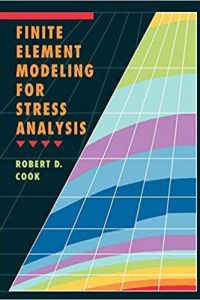
Finite Element Modeling for Stress Analysis
Robert D. Cook
University of Wisconsin – Madison
Chapter 1
Introduction
1.1 The Finite Element Method, 1
1.2 Elements and Nodes, 3
1.3 Modeling the Problem and Checking Results, 6
1.4 Discretization and Other Approximations, 9
1.5 Responsibility of the User, 10
1.6 Elementary Matrix Algebra, 12
Analytical Problems, 13
1
Chapter 2
Bars and Beams. Linear Static Analysis
2.1 Introduction, 17
2.2 Stiffness Matrix Formulation: Bar Element, 18
2.3 Stiffness Matrix Formulation: Beam Element, 20
2.4 Properties of k and K. Avoiding Singularity, 25
2.5 Mechanical Loads. Stresses, 26
2.6 Thermal Loads. Stresses, 30
2.7 An Application, 33
Analytical Problems, 36
Computational Problems, 38
17
Chapter 3
Plane Problems
3.1 Introduction, 41
3.2 Constant Strain Triangle (CST), 46
3.3 Linear Strain Triangle (LST), 47
3.4 Bilinear Quadrilateral (Q4), 48
3.5 Quadratic Quadrilateral (Q8), 50
3.6 Improved Bilinear Quadrilateral (Q6), 51
3.7 Elements with “Drilling” d.o.f., 54
3.8 Elements of More General Shape, 55
41
Vllvm Contents
3.9 Loads, 56
3.10 Stress Calculation. Other Remarks, 59
3.11 Comparative Examples, 62
3.12 An Application, 63
Analytical Problems, 67
Computational Problems, 70
Chapter 4
Isoparametric Elements and Solution Techniques 75
4.1 Node Numbering and Matrix Sparsity, 75
4.2 Equation Solving, 77
4.3 Transformations, 78
4.4 Isoparametric Elements: Formulation, 80
4.5 Gauss Quadrature and Isoparametric Elements, 82
4.6 Choice of Quadrature Rule. Instabilities, 84
4.7 Stress Calculation and Gauss Points, 86
4.8 Nature of Finite Element Solution, 86
4.9 Convergence Requirements. Patch Test, 88
4.10 Infinite Media and Infinite Elements, 89
4.11 Substructures, 90
4.12 Symmetry, 92
4.13 Constraints, 95
Analytical Problems, 98
Computational Problems, 103
Chapter 5
Modeling, Errors, and Accuracy in Linear Analysis 105
5.1 Modeling in General, 105
5.2 Structure Behavior and Element Behavior, 106
5.3 Element Tests and Element Shapes, 110
5.4 Test Cases and Pilot Studies, 113
5.5 Material Properties, 114
5.6 Loads, 116
5.7 Connections, 118
5.8 Boundary Conditions, 122
5.9 Planning the Analysis, 124
5.10 Numerical Error: Sources and Detection, 126
5.11 Common Mistakes, 130
5.12 Checking the Model, 131
5.13 Critique of FE Results, 133
5.14 Stress Concentrations. Submodeling, 136
5.15 Convergence with Mesh Refinement, 138
5.16 Error Measures and Adaptivity, 141Contents IX
Chapter 6
Solids and Solids of Revolution 145
6.1 Introduction, 145
6.2 Elements for 3D Solids, 149
6.3 A 3D Application, 152
6.4 Axisymmetric Solid Elements, 155
6.5 An Axisymmetric Application, 157
6.6 Nonaxisymmetric Loads, 161
Analytical Problems, 164
Computational Problems, 166
Chapter 7
Plates and Shells 171
7.1 Plate Displacements, Strains, and Stresses, 171
7.2 Finite Elements for Plates, 175
7.3 A Plate Application, 181
7.4 Shells and Shell Theory, 184
7.5 Finite Elements for Shells, 186
7.6 An Axisymmetric Shell Application, 190
7.7 A General Shell Application, 192
Analytical Problems, 196
Computational Problems, 198
Chapter 8
Thermal Analysis 205
8.1 Introduction. Some Basic Equations, 205
8.2 Finite Elements in Thermal Analysis, 208
8.3 Radiation and Other Nonlinearities, 211
8.4 Thermal Transients, 212
8.5 Modeling Considerations, 213
8.6 An Application, 215
Analytical Problems, 220
Computational Problems, 222
Chapter 9
Vibration and Dynamics 227
9.1 Introduction, 227
9.2 Basic Equations. Vibration, 227
9.3 Mass Matrices, 230
9.4 Undamped Free Vibration, 232
9.5 Damping, 234
9.6 Reduction, 235
9.7 Modal Equations, 237x Contents
9.8 Harmonic Response Analysis, 239
9.9 Dynamic Response Analysis, 241
9.10 Response Spectrum Analysis, 244
9.11 Remarks. Modeling Considerations, 246
9.12 An Application: Vibration and Harmonic Response, 258
9.13 An Application: Dynamic Response, 261
Analytical Problems, 265
Computational Problems, 268
Chapter 10
Nonlinearity in Stress Analysis 275
10.1 Introduction, 275
10.2 Solution Algorithms. Convergence Criteria, 277
10.3 Stress Stiffening, 280
10.4 Geometric Nonlinearity and Buckling, 283
10.5 Material Nonlinearity, 286
10.6 Problems of Gaps and Contact, 289
10.7 Remarks. Modeling Considerations, 292
10.8 Applications, 295
Analytical Problems, 299
Computational Problems, 301
References 309
Index 315
كلمة سر فك الضغط : books-world.net
The Unzip Password : books-world.net
تحميل
يجب عليك التسجيل في الموقع لكي تتمكن من التحميل
تسجيل | تسجيل الدخول


